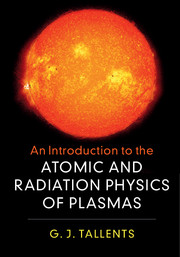Book contents
- Frontmatter
- Contents
- Preface
- 1 Plasma and Atomic Physics
- 2 The Propagation of Light
- 3 Scattering
- 4 Radiation Emission in Plasmas
- 5 Radiation Emission Involving Free Electrons
- 6 Opacity
- 7 Discrete Bound Quantum States: Hydrogen and Hydrogen-Like Ions
- 8 Discrete Bound States: Many-Electron Atoms and Ions
- 9 Discrete Bound States: Molecules
- 10 Radiative Transitions between Discrete Quantum States
- 11 Collisions
- 12 Collisional-Radiative Models
- 13 High-Density Plasmas
- Appendix Vectors, Maxwell's Equations, the Harmonic Oscillator and a Sum Rule
- References
- Index
12 - Collisional-Radiative Models
Published online by Cambridge University Press: 21 February 2018
- Frontmatter
- Contents
- Preface
- 1 Plasma and Atomic Physics
- 2 The Propagation of Light
- 3 Scattering
- 4 Radiation Emission in Plasmas
- 5 Radiation Emission Involving Free Electrons
- 6 Opacity
- 7 Discrete Bound Quantum States: Hydrogen and Hydrogen-Like Ions
- 8 Discrete Bound States: Many-Electron Atoms and Ions
- 9 Discrete Bound States: Molecules
- 10 Radiative Transitions between Discrete Quantum States
- 11 Collisions
- 12 Collisional-Radiative Models
- 13 High-Density Plasmas
- Appendix Vectors, Maxwell's Equations, the Harmonic Oscillator and a Sum Rule
- References
- Index
Summary
In a plasma in complete thermodynamic equilibrium, the radiation field is given by the Planck black-body expression (see Section 4.1), the ionisation is determined by the Saha-Boltzmann equation (see Section 1.4.1) and the population ratios of bound quantum states are determined by the Boltzmann ratio. In local thermodynamic equilibrium (LTE), quantum state populations are given by the Saha-Boltzmann equation and Boltzmann ratio, but the radiation field is not in equilibrium with the particles. We discuss the plasma conditions needed to establish equilibrium later in this chapter, but it is worthwhile to note that LTE often occurs when collisional processes dominate the populating and de-populating of the quantum state populations and radiative processes are not significant.
Radiative rates of decays for bound quantum states were determined in Section 10.1 and between free and bound states in Section 5.4. The cross-sections for collisional processes were discussed in Chapter 11. The cross-sections depend on the energy of the incident colliding electron, but in a plasma we have a Maxwellian distribution of the energies of the free electrons. The cross-section values need to be averaged over the Maxwellian distribution to produce a rate coefficient which when multiplied by the density of free electrons and the initial quantum state density yields the rate of change of the quantum state. The radiative reactions involved were listed in Table 11.1. A list of collisional reactions affecting quantum state populations has been given in Table 11.2. Models calculating plasma quantum state densities and consequent radiation emission and absorption properties using rates of radiative and collisional processes are known as collisional radiative models [89].
Collisional Excitation and De-Excitation
Our investigation of cross-sections for excitation by inelastic electron collisions has shown a variation with the energy E of the incident electron approximately proportional to 1/E (see Section 11.4). The cross-section for collisional excitation can be written in terms of a collision strength Ωpq(E) such that
where πa 2 0 is a cross-section for the ground state of the hydrogen atom (taken as the area associated with the Bohr radius a 0) and gp is the degeneracy of the initial quantum state. ‘Effective collision strengths’ γpq are tabulated for different temperatures where the collision strength has been averaged over the electron distribution.
Information
- Type
- Chapter
- Information
- An Introduction to the Atomic and Radiation Physics of Plasmas , pp. 226 - 254Publisher: Cambridge University PressPrint publication year: 2018
